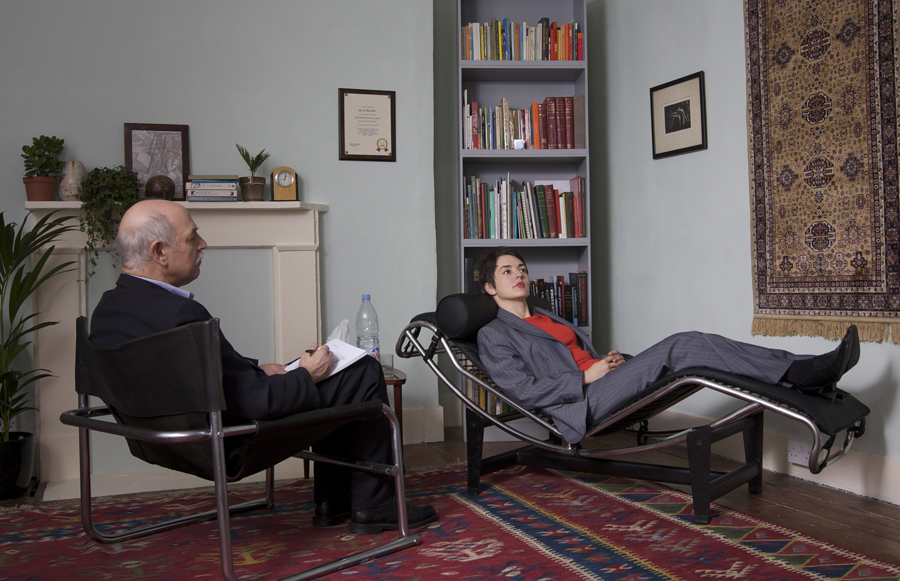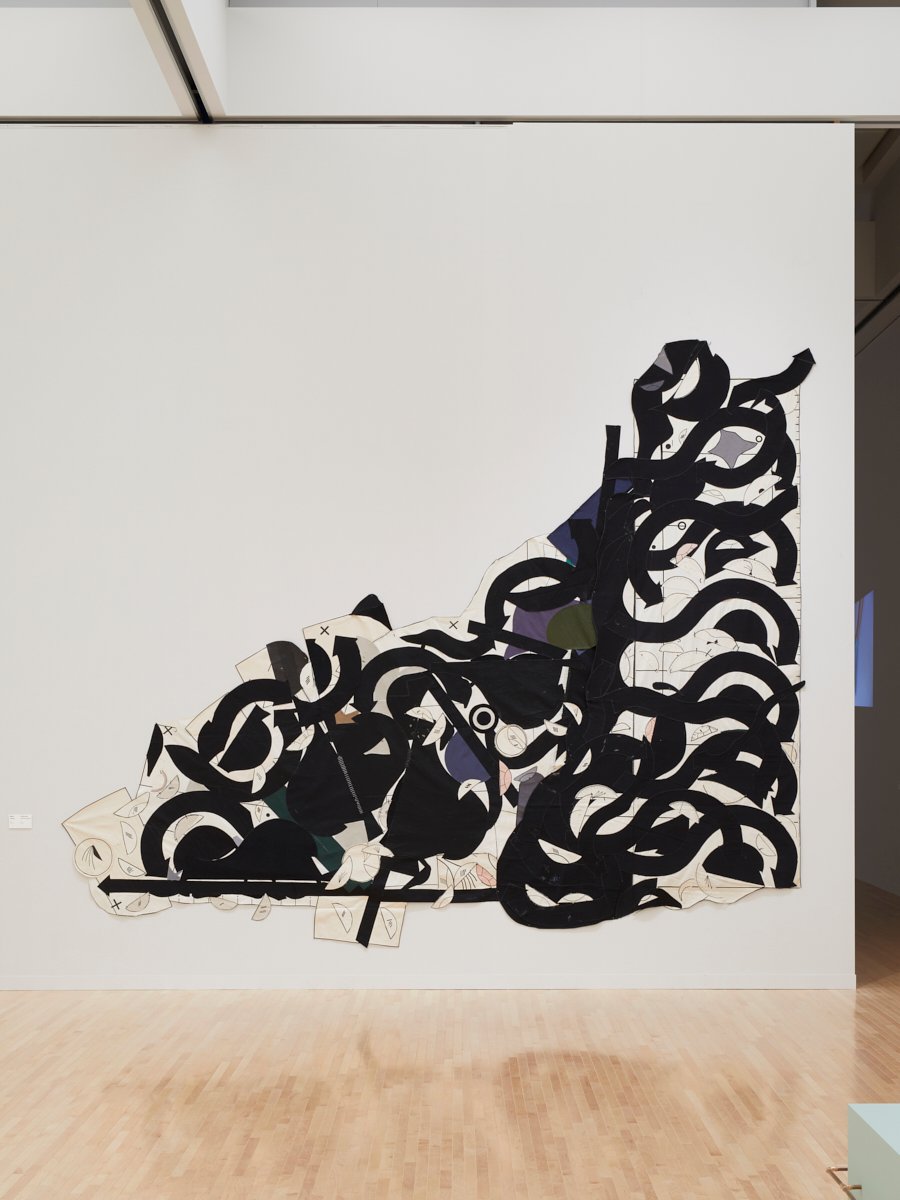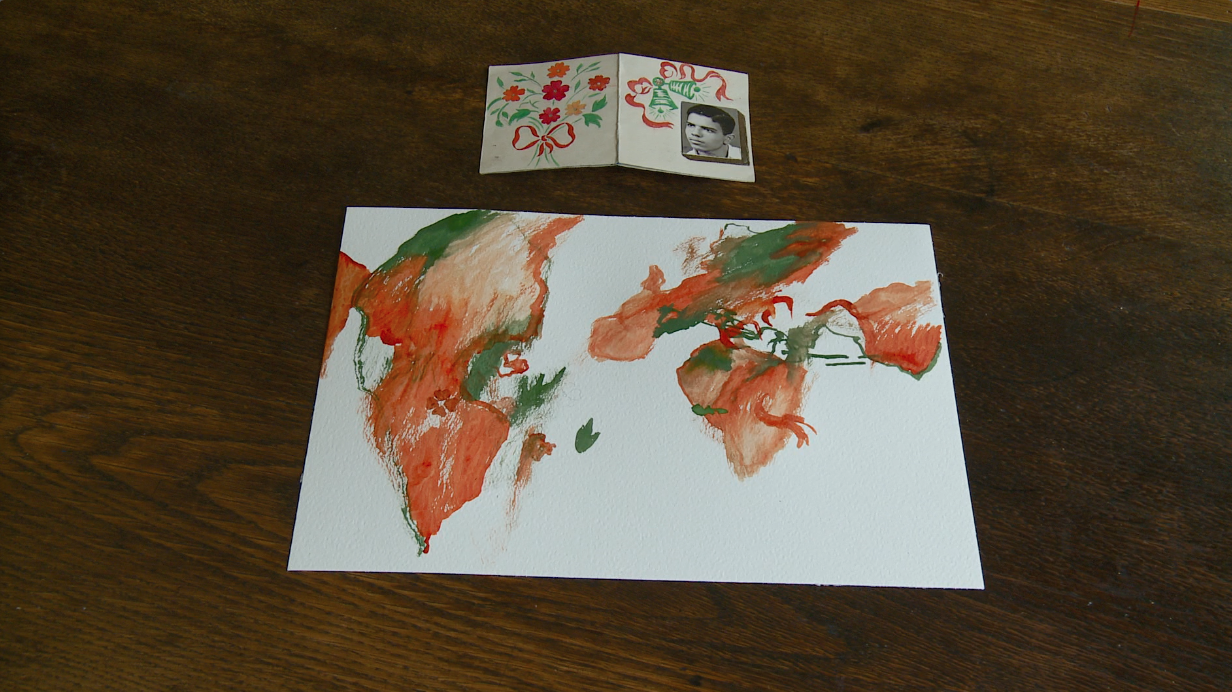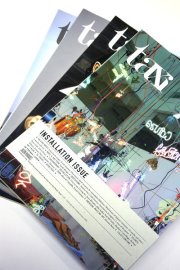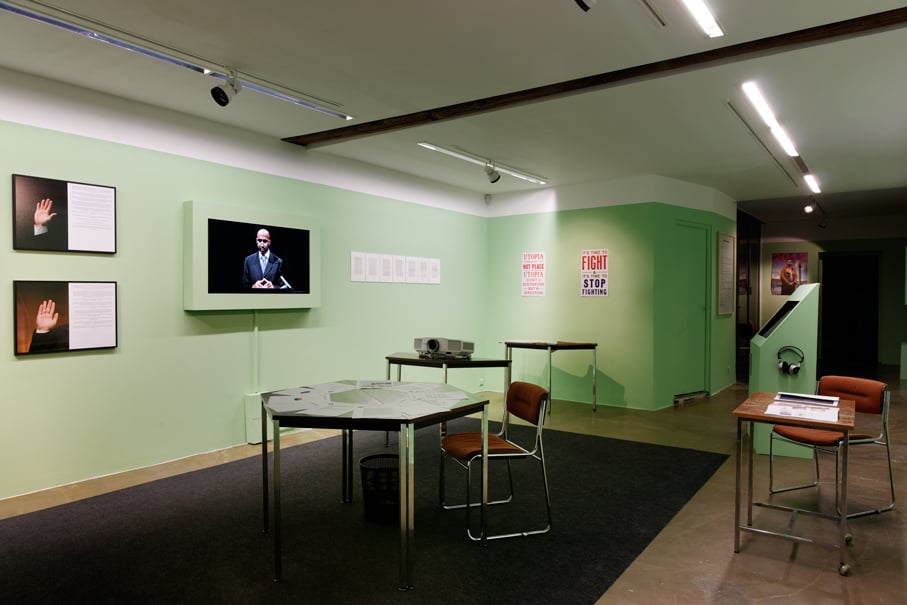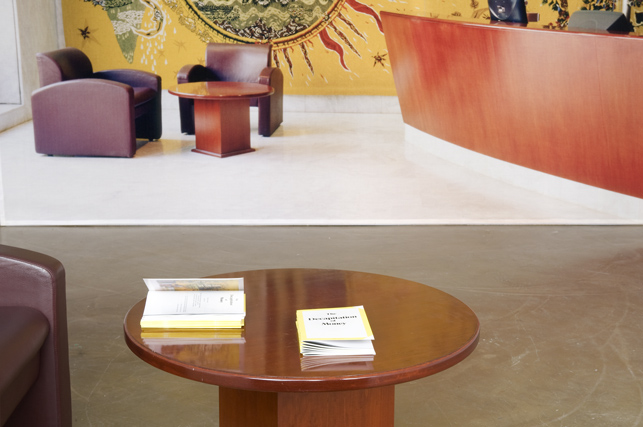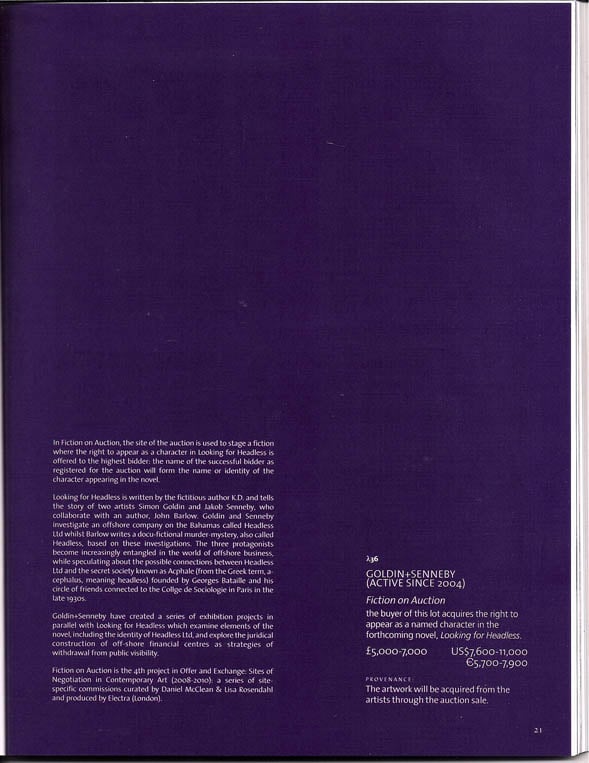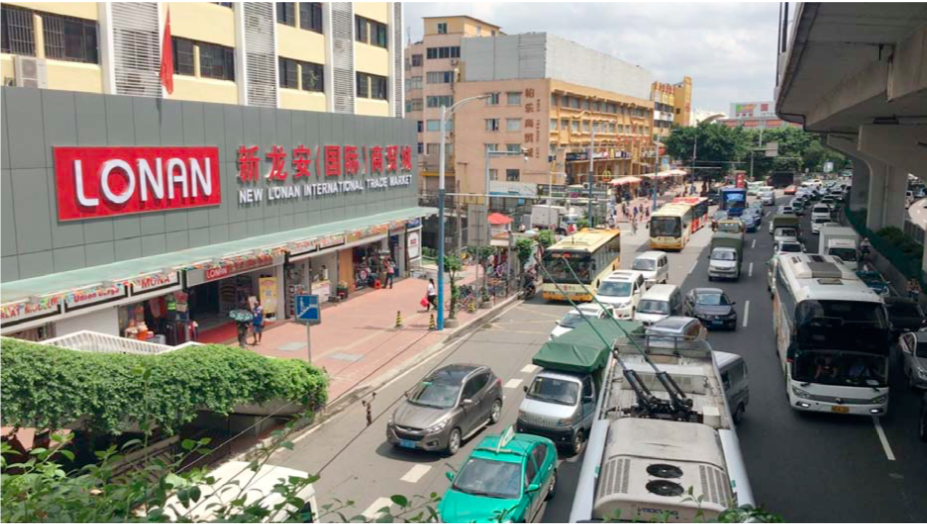
© » KADIST
Mazenett Quiroga
Gente Serpiente (Serpent People) is a piece made with the wheels of bikes, twisted, intertwined and painted like skins of tropical poisonous snakes. This sculpture, as well as other pieces by Mazenett and Quiroga, seeks to reveal and re-inscribe everyday and ordinary objects within a mythological tradition, to reconnect them with an origin in order to recognize their hidden life and meaning. These objects represent the life cycle and the animal, as well as cultural and geological time: long ago they were marine organisms and through the action of sand, sediment and mud, in oil, then in wheels they are transformed.

© » KADIST
Farah Al Qasimi
Um Al Dhabaab (Mother of Fog) by Farah Al Qasimi addresses the myth of Al Qasimi tribe-instigated piracy in the Gulf, perpetuated by the British Empire and upheld by contemporary western academia. This narrative is contested through a fictional retelling of the 1819 siege of Al Dhayah fort and the subsequent Pax Britannica treaty that solidified Britain’s military presence in the Trucial States. Relayed across various locations and times in Ras Al Khaimah through the perspectives of an ancient jinn, the ghost of an Al Qasimi pirate, two RAK-based sisters, a Jack Sparrow impersonator and ship captain, and an 1819 British naval officer, the film challenges Western-centric historiographies of the Gulf and the lingering imperialist interests at play across Asia’s modern-day trade hubs.

© » KADIST
Chia-Wei Hsu
The word Takasago alludes to several things at once. Takasago is the name of a multi-billion dollar Japanese corporation, previously situated in Taiwan pre-World War II. It is also a famous Japanese Noh play, the oldest extant form of performance in Japan, combining dance, costuming/masks, acting, and operatic chants.

© » KADIST
Li Jinghu
Benefiting from its geographic proximity to Hong Kong, since the 1980s Dongguan has become the factory of the world, with toys, plastic products and clothing as the major industries in the town. During its heyday, the region produced 50% of the world’s manufactured toys, but since 2008, the toy industry has declined as the factories moved to South East Asia. Archaeology of the Present (Dongguan) No.

© » KADIST
Li Xiaofei
Combined into a single two-channel HD video, Li Xiaofei’s Ponytail and Chongming Island II are silent portraits of the women assembly line workers at a Chinese kitchenware factory. Close-up shots of women’s heads—most notably of the rear with their hair in the similar updo fashion—and faces occupy the frame amidst a backdrop of a revolving steel conveyor. In lieu of dialogue or humming of the machinery, a ringing score of chimes and bells provides a tranquil soundtrack.

© » KADIST
Bahar Noorizadeh
The Red City of the Planet of Capitalism is part of a three project lineage, following Bahar Noorizadeh’s research on the architecture of the Soviet Union. The video focuses on the peculiar story of the Russian architect Moisei Ginzburg, who, in the late 1920s, suddenly turned his back on Le Corbusier, the French father of urbanist modernism. While Ginzburg had been a fervent follower of Le Corbusier’s philosophy, the story says that he was converted to disurbanism in only half an hour by the urban sociologist Mikhail Okhitovich.

© » KADIST
Sable Elyse Smith
Sable Elyse Smith’s Pivot III resembles playground equipment uselessly reconfigured. The stainless-steel asterisks, assembled from prison visitation-room seating, are painted 2K black and blue: colors evoking the US criminal justice system, its racist enforcement, and the heavy-duty finish of finance capitalism with which the culture industry is enmeshed. The work consists of six long rods, affixed via plate to each of the faces of a central cube, from which they radiate in perfect symmetry.

© » KADIST
Takeshi Murata
If one had been guessing at Takeshi Murata’s criticism of American consumerist culture up until watching Infinite Doors , it would be solidified after hearing the announcer from The Price is Right squawk prizes one after the next. In the two minutes of the film’s runtime, can count the word “new” used twenty-eight times, and “car”—the holy grail of prizes on that show—used eight times. The bodacious women introduce free prizes, the doors slide open repeatedly, and the crowd cheers with an insatiable appetite in a clear signal of an American propensity for numbing overconsumption.

© » KADIST
Nagendra Gurung
Chalis Katesi Ramaula is a series of 240 prints capturing Nagendra Gurung’s life, work, and colleagues from the construction sites where he has worked in Dubai and Saudi Arabia. When seen together, the sequence appears to have a cinematic temporality, as one feels the passing of the years he has endured as a migrant worker. Gurung’s subjectivity is highly present, even when looking at the most banal scenes of cranes, concrete, and other machinery, which are rapidly transforming the landscape and society of the Gulf into its own version of capitalist futurism built through the exploitation of others.

© » KADIST
Santu Mofokeng
Since the global capital expansion, billboards have been the medium of communication between the rulers and the residents of townships. In South Africa, a billboard is a relic from the times when Africans were subjects of power and when townships were restricted areas, subject to laws, municipality by-laws and ordinances regulated the movement of persons and governed who may or may not enter the township. Mofokeng references this medium for control through tracing the history of townships in South Africa.

© » KADIST
Gao Mingyan
The television monitors utilized in the video installation Come On (2008) ostensibly serve as playback devices for a multi-channel installation of clips from blockbuster films as part of a larger commentary of mass entertainment and its relation to consumer cultures. Arranged in a grid, however, the monitors begin to resemble closed circuit security systems, evoking associations of surveillance and policing. More than just casual documents of the every day, Gao’s video works carry a subversively political charge and force viewers to reconsider their own relationship to media and perception.

© » KADIST
Adriana Martínez
Her 2015 work Orión is a black flag-like cloth with glow-in-the-dark symbols embroidered in the shape of the constellation. In the place of stars, Martínez has substituted the logos of international corporations and entities that use stars as their symbol; celestial navigation commanded by the logic of international corporations. Easily spotted is the smiling face of the Carl’s Jr. / Hardee’s logo, the three-pronged Mercedes-Benz emblem, Walmart’s six-pointed asterisk, and the starry cluster of the Subaru shield.

© » KADIST
Yuyan Wang
The Moon Also Rises by Yuyan Wang comprises a one-channel video and light installation. The work is based on a 2018 initiative in China to launch three artificial moons into orbit above major cities to provide continuous daylight. Set in an oppressively illuminated environment, the images depict lethargic crowds in megacities, surrounded by glowing neon lights, and workers in LED factories performing repetitive tasks on an assembly line in a kind of trance state.

© » KADIST
Zhou Tao
Created for the Seventh Shanghai Biennale at the Shanghai Art Museum, Zhou Tao’s 1,2,3,4 records morning staff meetings in over forty shops and companies in the immediate vicinity of the People’s Square. Regardless of occupation, the employees count off and move in step to the rhythms of their companies’ corporate songs or chants, which are meant to build team spirit and corporate loyalty. Zhou’s practice alchemizes the ordinary surroundings into a theatre where his camera is not simply a recording apparatus but an extension of existence.

© » KADIST
Andrew Norman Wilson
Chase ATM emitting blue smoke, Bank of America ATM emitting red smoke, TD Bank ATM emitting green smoke was shot in the American Southwest at Mid-century modern architectural structures that were built to house regional independent banks and have since been bought up by Chase, Bank of America, and TD Bank. The video utilizes transparency and opacity effects in multimedia software to question the perceptibility of finance. It offers a complex metaphor (toxic assets, emergency flares, house/mortgage on fire) about the financial sector and the effects of the ‘crisis’ that led to the disappearance (and the ghostly memory) of many local and regional banks.

© » KADIST
Sylbee Kim
Sylbee Kim’s Unindebted Life is a single-channel video, commissioned and premiered at the 13th Gwangju Biennale (2021). This work is a major production by the artist, addressing her attempts to attractively integrate and intersect elements such as bodies and minds, ancient spirituality, heterogeneity, class and capital, digital temporality, and particular aesthetics of the post-internet generation. In the work, the vitality and the movement in calligraphy motifs, revealed through the flashing light presented in the screen panels and video sequences, are related to the moment of change inherent in the body’s cell energy and living things.

© » KADIST
Natsuko Uchino
Squid Currency is a series of 13 non-calibrated double-sided tin coins made using a casting technique dating back to Neolithic times where cuttlebones (squid bones) were carved by hand and then used as a mold. Natsuko Uchino draws on research into tin mining across the world, which takes place largely in China and Bangladesh as well as in Potosi, Bolivia where silver has been depleted due to the production of coins and other ornate riches during the 16th century Spanish Empire. Tin has a low melting point and is easily up-cycled from vessels such as measuring cups and kitchen utensils found at yard sales.

© » KADIST
Sancintya Mohini Simpson
Dhuwã (term used by indentured people of Natal for ‘smoke’), is a single-channel film by Sancintya Mohini Simpson that traces back to the lived experiences of indentured labourers taken from India to Natal (now KwaZulu-Natal, South Africa) to work on sugar plantations during the late 1800s and early 1900s. This often-overlooked chapter in colonial history is close to the artist, as her maternal family were contracted to a sugar plantation in Natal. Filmed originally in 16mm film, Dhuwã captures sugarcane plantations in North Queensland, initially in moments of stillness that are gradually disrupted by a crescendo of repetitive sounds and fast camera movements that culminate in the fields being engulfed by flames.

© » KADIST
Jeamin Cha
Fog and Smoke is the first video Jeamin Cha made after returning to Seoul from London where she studied and started as an investigation into the meaning of “otherness” in documentary filmmaking. The opening scene depicts an abandoned construction site that had once been part of the Songdo International Business District in Incheon, near Seoul. In the dark of the night, the sounds of a countdown and piano notes fill an empty apartment building and echoes far into the unknown corners and hollows of a newly built city.

© » KADIST
Danielle Dean
In 2003, Nike released a pair of red and black sneakers (the Dunk Low Pro SB ) that were marketed as “vampire” sneakers. Danielle Dean’s work True Red examines how a large corporation co-opted a historical fiction (the vampire), in addition to the traditional red and black colors of radical politics and the avant-garde. The animated video considers how capitalism can gentrify notions of radicality and the mutable nature of advertising.

© » KADIST
Miao Ying
As part of her project Chinternet Plus , a “counterfeit ideology” and parodic take on the strategy “Internet Plus” launched by Chinese Prime Minister Li Keqiang in 2015, the video work Post commentary, monetary likes, Morgan Freeman’s advice on reality gives an insight into Internet Culture in China. The brilliantly edited video by Miao Ying presents various scenes from a popular Chinese live-streaming platform together with extracts from a TV show featuring Morgan Freeman talking about “What Is Reality”. This work is exemplary of the artist’s practice, questioning, with a degree of humour, the sometimes dramatic consequences of the Internet as it consumes society.

© » KADIST
Rodrigo Torres
Drawing & Print (Drawing & Print)
In his Conceito abstrato series, however, Rodrigo Torres turns to the abstract, using the shapes, numbers, lines, and subtle colors of international currencies to create non-representational forms with lavish geometries and baroque curving forms.

© » KADIST
Taloi Havini
Following her family’s political exile to Australia in 1990, Havini began to document her journey’s home to the north of Buka Island, in the Autonomous Region of Bougainville. Reflecting on the still visible aftermath of conflict and changing economic factors, Havini creates traditional beroana or shell money from extracted earth materials only found on Solomon islands like Bougainville. Havini’s whirling assemblage of ceramic discs emulate the strings of shell money (still valid around the Pacific as system of payments) to examine the economic changes that occurred in her homeland.

© » KADIST
UuDam Tran Nguyen
Like many Asian countries, Vietnam has lost an immense amount of natural environment and rural landscape to economic growth and industrial development. The single-channel video Waltz of the Machine Equestrians is a response to the overwhelming number of motorbikes and scooters overtaking the streets of Vietnam as small agrarian communities have been displaced by the construction of skyscrapers. The video shows 28 “equestrians” on motorbikes and scooters arrayed into a rainbow cavalcade held together by strings clipped onto brightly colored ponchos.

© » KADIST
Mona Benyamin
A moonscape is a vista of the lunar landscape or a visual representation of this, such as in a painting. The term “moonscape” is also sometimes used metaphorically for an area devastated by war. Moonscape by Mona Benyamin is inspired by and dedicated to the Lunar Embassy—a company that now sells land on a variety of planets and moons, established in 1980 by a man called Dennis M. Hope, who claimed ownership of the Moon.

© » KADIST
Eddie Arroyo
5901 NW 2nd Ave., Miami, FL 33127 (Botanica) is a series of paintings that artist Eddie Arroyo created over an extended period of time, depicting the same site as it appeared from 2016 to 2018. Like the series shown at the Whitney, their focus is a building complex that until recently housed a Voodoo Botanica and Variety Shop, another iconic set of businesses on NE 2nd Avenue in Little Haiti that housed practitioners of voodoo proffering candles, potions, and incense. It was one of many businesses in the area bearing paintings by Serge Toussaint, a local artist and professional sign painter known for his portrayals of Little Haiti.

© » KADIST
Shahryar Nashat
In the film Hustle in Hand (2014) we observe secret negotiations carried out between two characters with only their torsos visible in the frame— negotiations that consider fetishizations, meaning and symbolic value of the body and flesh. Money, food, appearances, and consumption: the viewer is pulled into a round of transactions, a rumination on our society in which art occupies a coveted position. The film’s rhythm is suddenly interrupted by the appearance of a green polyhedron that, once licked by one of the mysterious protagonists, becomes golden yellow, a magical event accompanied by an intense swelling of violin music.

© » KADIST
Korakrit Arunanondchai
His untitled paintings express his concern regarding perception in abstract form. Made with bleached denim, stock images of flames and gold leaf, these works embody “human cultures as ghosts.” The gold serves as a reminder of religious paintings, and the denim as emblematic of Western capitalist waste. When describing his paintings, the artist states, “The idea of what Painting is or could be became somehow akin to the image of the earth, as seen from above, from the viewpoint of a drone or a spirit.
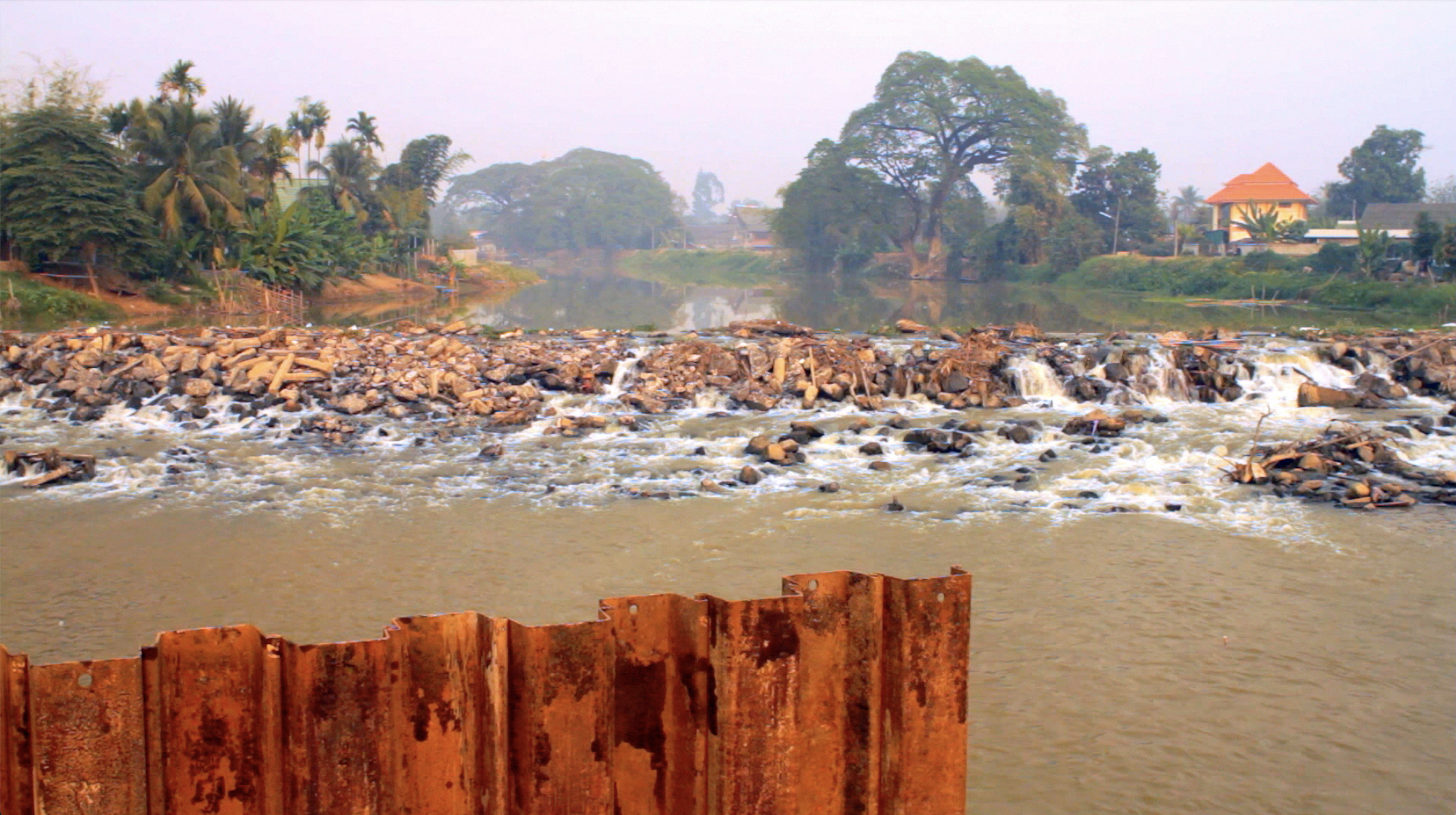
© » KADIST
Som Supaparinya
The flat, wide river holds on its surface a tour-boat of memories, as Som Supaparinya documents her Grandfather’s return via cruise to familiar territories in rural Thailand that were submerged after the Thai government installed a series of dams. An unsettling sense of trauma emerges from the absence of what is being described in My Grandpa’s Route has been Forever Blocked . Supaparinya’s juxtaposition of unceasing waterways and cruise life with a series of dams, obstinately responsible for these conditions.

© » KADIST
Ana Navas
Ana Navas uses humor to address formal, aesthetic, and societal conventions that are interwoven in the everyday through the normalization of gendered behaviors and style choices used to project personal and collective signifiers. In her Donation Vases she uses quotes taken from corporate coach Lois P. Frankel’s book Nice girls (still) don’t get the corner office: Unconscious Mistakes Women Make That Sabotage Their Careers (2004). The aspirational, somewhat cynical tone of the sentences – “When given a choice, sit next to most powerful person, their power will cascade over you,” “Why is it that women buy those little chains to hang reading glasses around their necks,” “If you see your reflection on a glossy surface & notice something wrong, avoid fixing it there” – reveals a particular understanding of what a professional, ambitious cis woman should look like, the persona she should project, and the type of desirable behaviors that constitute a stereotypical “successful woman” according to a capitalist morality.
Carey Young
- location: Lusaka, Zambia
- year born: 1970
- gender: female
- nationality: Zambian
Danielle Dean
Danielle Dean creates videos that use appropriated language from archives of advertisements, political speeches, newscasts, and pop culture to create dialogues to investigate capitalism, post-colonialism, and patriarchy...
Bahar Noorizadeh
Bahar Noorizadeh is filmmaker, writer, and platform designer...
Jeamin Cha
Jeamin Cha’s questions exist in the gyre between individual and social environment, stepping over conspicuous strands of relation between the two in favor of cultivating characters that dwell in the night, under-noticed or otherwise surplus figures outside of mainstream societal representation...
Shahryar Nashat
The work of Shahryar Nashat (b...
UuDam Tran Nguyen
- nationality: Vietnamese
Matt Kane
Trained as a visual artist, Matt Kane left the art world for a decade to work as a web developer in the United States’s Pacific Northwest...
Brook Andrew
Brook Andrew is a Wiradjuri and Ngunnawal Aboriginal Australian artist and scholar whose interdisciplinary practice examines hegemonic narratives relating to colonialism and modernism...
Eddie Arroyo
Eddie Arroyo is a painter who documents residential and commercial structures that will soon be replaced by new development, chronicling the negotiations of the cultural, social, and economic fabric of a community...
Tina Modotti
- location: Mexico City, Mexico
- year born: 1896
- gender: female
- nationality: Italian
- home town: Udine, Italy
Chia-Wei Hsu
Embarking from myriad audio-visual narratives, Chia-Wei Hsu pursues imaginative interrogations of cultural contact and colonization in Asia, oftentimes amalgamating his primary narratives with non-human actors including technologies, animals, gods, environments, traditions, and material objects...
Minerva Cuevas
- location: Mexico City, Mexico
- year born: 1975
- gender: female
- nationality: Mexican
- home town: Mexico City, Mexico
Nadia Myre
The work of Nadia Myre, member of the Kitigan Zibi Anishinabeg First Nation, is notable for its embrace of cross-cultural mediations as a strategy towards celebrating and reclaiming the far-reaching intellectual and aesthetic contributions of Indigenous communities...
Marie Voignier
Marie Voignier’s work presents a subtle criticism of the transitory status of action within the social and political elds...
Karrabing Film Collective
Karrabing Film Collective is an indigenous media group consisting of over 30 members, bringing together Aboriginal filmmakers from Australia’s Northern Territory...
Santu Mofokeng
The photographic artwork of Santu Mofokeng (b...
Mazenett Quiroga
Mazenett Quiroga have been working collaboratively in Bogotá, Colombia for the past nine years...
Sable Elyse Smith
Sable Elyse Smith is an interdisciplinary artist, writer, and educator based in New York and Richmond, Virginia...
Korakrit Arunanondchai
Born in 1986 in Bangkok, Thailand, Korakrit Arunanondchai now lives and works in New York and Bangkok...
Sylbee Kim
Sylbee Kim’s video installations reflect economic uncertainty and ecological urgencies through digital and physical compositions...
Cao Fei
- location: Beijing, China
- year born: 1978
- gender: female
- nationality: Chinese
- home town: Guangzhou, China
Reyes Santiago Rojas
Reyes Santiago Rojas works with themes relates to nature, patience and garbage...
Sancintya Mohini Simpson
Sancintya Mohini Simpson is an artist, writer, and researcher whose work addresses the impact of colonization on the historical and lived experiences of her family and broader diasporic communities...
Andrew Norman Wilson
Andrew Norman Wilson is an artist, curator, and filmmaker whose practice is mostly based in research and documentary...
Li Jinghu
Li Jinghu was born in 1972 in Dongguan, Guangdong, where he currently lives and works...
Zhou Tao
Artist Zhou Tao has a diverse and varied practice, and notably, he denies the existence of any singular or real narrative or space...
Liu Yu
Liu Yu has developed a multifaceted artistic practice that takes field documentation as its point of departure...
Rodrigo Torres
Brazilian artist Rodrigo Torres has been deconstructing international paper currencies to form intricate collages of color, line, shape, and texture for several years...
Hit Man Gurung
Hit Man Gurung was born in Lamjung, Nepal and is currently based in Kathmandu...
-
1920-1929
Tina Modotti
1927Modotti’s Diego Rivera Mural: Billionaires Club; Ministry of Education, Mexico D...
-
1980-1989
Santu Mofokeng
1985Since the global capital expansion, billboards have been the medium of communication between the rulers and the residents of townships...
-
2000-2009
Wong Hoy Cheong
2004Re: Looking marks a new phase in Wong’s work which connects his region’s history with other parts of the world...
Nagendra Gurung
2005Chalis Katesi Ramaula is a series of 240 prints capturing Nagendra Gurung’s life, work, and colleagues from the construction sites where he has worked in Dubai and Saudi Arabia...
Minerva Cuevas
Drawing & Print
2006(Drawing & Print) During her research on primitive currencies and cultural cannibalism, Cuevas came across the Donald Duck comic book issue “The Stone Money Mystery,” where Donald goes on a quest to find missing museum objects...
Carey Young
2007“Product Recall” is a video perfomative pun on the action recalling memories in the form of a psychoanalytic session and the recall of faulty products from multinational corporations...
Aaron Young
2007The artist describes the work as “very performative video-pieces but they take on a more sculptural feel...
Gao Mingyan
2008The television monitors utilized in the video installation Come On (2008) ostensibly serve as playback devices for a multi-channel installation of clips from blockbuster films as part of a larger commentary of mass entertainment and its relation to consumer cultures...
-
2010-2019
Takeshi Murata
2010If one had been guessing at Takeshi Murata’s criticism of American consumerist culture up until watching Infinite Doors , it would be solidified after hearing the announcer from The Price is Right squawk prizes one after the next...
Ciprian Muresan
2011The video I am protesting against myself presents a puppet in a garbage can citing numerous reasons why one should protest against it...
Jason Meadows
2011Jason Meadows’s Do Not Pass Go (2011) depicts Richie Rich, “the poor little rich boy” of the 1950s comic strip...
UuDam Tran Nguyen
2012Like many Asian countries, Vietnam has lost an immense amount of natural environment and rural landscape to economic growth and industrial development...
Som Supaparinya
2012The flat, wide river holds on its surface a tour-boat of memories, as Som Supaparinya documents her Grandfather’s return via cruise to familiar territories in rural Thailand that were submerged after the Thai government installed a series of dams...
Sebastián Díaz Morales
2012Pasajes I is the first in a series of Sebastián Díaz Morales’s four videos Pasajes , which focuses on a solitary man walking through Buenos Aires...
Jeamin Cha
2013Fog and Smoke is the first video Jeamin Cha made after returning to Seoul from London where she studied and started as an investigation into the meaning of “otherness” in documentary filmmaking...
Andrew Norman Wilson
2014Chase ATM emitting blue smoke, Bank of America ATM emitting red smoke, TD Bank ATM emitting green smoke was shot in the American Southwest at Mid-century modern architectural structures that were built to house regional independent banks and have since been bought up by Chase, Bank of America, and TD Bank...
Shahryar Nashat
2014In the film Hustle in Hand (2014) we observe secret negotiations carried out between two characters with only their torsos visible in the frame— negotiations that consider fetishizations, meaning and symbolic value of the body and flesh...
Adriana Martínez
2015Her 2015 work Orión is a black flag-like cloth with glow-in-the-dark symbols embroidered in the shape of the constellation...
Taloi Havini
2015Following her family’s political exile to Australia in 1990, Havini began to document her journey’s home to the north of Buka Island, in the Autonomous Region of Bougainville...
Reyes Santiago Rojas
2015The work Sarta (String) by Reyes Santiago Roja is part of a larger series of works that examine the commercialization of the tobacco plant and its relationship to the meaning and use of tobacco by Native American tribes such as the Mayas, Aztecs, Incas or Tainos, which attributed spiritual qualities to tobacco such as the smoke carrying one’s thoughts and prayers to the sprits...
Adriana Martínez
2015Her work Al final del arcoiris (At the end of the rainbow, 2015) is a bundle of bills from Chile, Venezuela, Brazil, Colombia, Nicaragua, and Costa Rica, arranged by color to form a tight spiraling rainbow held close with a rubber band...
Danielle Dean
2016In 2003, Nike released a pair of red and black sneakers (the Dunk Low Pro SB ) that were marketed as “vampire” sneakers...
Miao Ying
2016As part of her project Chinternet Plus , a “counterfeit ideology” and parodic take on the strategy “Internet Plus” launched by Chinese Prime Minister Li Keqiang in 2015, the video work Post commentary, monetary likes, Morgan Freeman’s advice on reality gives an insight into Internet Culture in China...
Rodrigo Torres
Drawing & Print
2016(Drawing & Print) In his Conceito abstrato series, however, Rodrigo Torres turns to the abstract, using the shapes, numbers, lines, and subtle colors of international currencies to create non-representational forms with lavish geometries and baroque curving forms....
Eddie Arroyo
20165901 NW 2nd Ave., Miami, FL 33127 (Botanica) is a series of paintings that artist Eddie Arroyo created over an extended period of time, depicting the same site as it appeared from 2016 to 2018...
Olivia Erlanger
2016Sideways Time by Olivia Erlanger is the result of the artist’s interest in networks, seen and unseen, financial and ecological, the collapse of which has resulted in the fracturing of a middle class American identity...
Korakrit Arunanondchai
2017His untitled paintings express his concern regarding perception in abstract form...
Danielle Dean
2017In True Red Ruin (Elmina Castle) , Danielle Dean uses archival documents to re-imagine colonial history from the 1400s, while also referencing her own personal history...
Bahar Noorizadeh
2018After Scarcity is a sci-fi video-essay that tracks Soviet cyberneticians (1950s – 1980s) in their attempt to build a fully-automated planned economy...
Nadia Myre
2018First exhibited as part of the recent multidisciplinary project Code Switching and Other Work , at Art Mûr, Berlin in late 2018, Nadia Myre’s Untitled (Tobacco Barrel) takes inspiration from the cylindrical vessels used to import tobacco from North America to Europe during periods of early colonial settlement...
Karrabing Film Collective
2018The Mermaids, or Aiden in Wonderland by Karrabing Film Collective is a surreal exploration of Western toxic contamination, capitalism, and human and non-human life...
Agnieszka Kurant
Drawing & Print
2018(Drawing & Print) Agnieszka Kurant’s Placebo VIII brings together a series of imaginary pharmaceuticals invented within the fictional narratives of literature and film...
Mazenett Quiroga
2019Gente Serpiente (Serpent People) is a piece made with the wheels of bikes, twisted, intertwined and painted like skins of tropical poisonous snakes...
Matt Kane
Advanced Technology
2019(Advanced Technology) Matt Kane initiated the project Right Place & Right Time – Bitcoin Volatility Art in 2019...
-
2020-2029
Sable Elyse Smith
2020Sable Elyse Smith’s Pivot III resembles playground equipment uselessly reconfigured...
Natsuko Uchino
2020Squid Currency is a series of 13 non-calibrated double-sided tin coins made using a casting technique dating back to Neolithic times where cuttlebones (squid bones) were carved by hand and then used as a mold...
Mona Benyamin
2020A moonscape is a vista of the lunar landscape or a visual representation of this, such as in a painting...
Brook Andrew
2020This year: missing witness by Brook Andrew consists of a multi-layered collage of photographs...
Sylbee Kim
2021Sylbee Kim’s Unindebted Life is a single-channel video, commissioned and premiered at the 13th Gwangju Biennale (2021)...
Sancintya Mohini Simpson
2021Dhuwã (term used by indentured people of Natal for ‘smoke’), is a single-channel film by Sancintya Mohini Simpson that traces back to the lived experiences of indentured labourers taken from India to Natal (now KwaZulu-Natal, South Africa) to work on sugar plantations during the late 1800s and early 1900s...
Farah Al Qasimi
2022Um Al Dhabaab (Mother of Fog) by Farah Al Qasimi addresses the myth of Al Qasimi tribe-instigated piracy in the Gulf, perpetuated by the British Empire and upheld by contemporary western academia...
Bahar Noorizadeh
2022The Red City of the Planet of Capitalism is part of a three project lineage, following Bahar Noorizadeh’s research on the architecture of the Soviet Union...
Yuyan Wang
2022The Moon Also Rises by Yuyan Wang comprises a one-channel video and light installation...
